Apr 13, 2025
Apr 13, 2025
The invasion of Timurlane left Delhi sacked and in ruins. The once mighty city of the Delhi Sultanate, home to kings and dynasties, was left a shattered wreck. It took more than a century for the city to regain a semblance of its former prestige, first under the Sayyids and then under the Lodis. This was, as it would eventually turn out, a mere pause, for the death knell of the Sultanate had long been sounded, and it only remained for Babur to invade India to lay the foundation of that mightiest of dynasties in India – the great Mughals.
Still, this event was some years away. Building work in Delhi continued after a fashion, yet the prodigious output of the previous dynasties in terms of capitals, fortresses and civil work was replaced by a more somber, funerary architecture of tombs and mosques. In the words of Percy Brown, “Scores of large tombs therefore arose within its (Delhi’s) neighborhood, so much so that in the course of time the country around the capital was converted into a large necropolis.”*
The Sultans and the Nobles
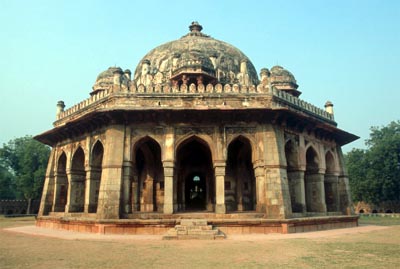 A closer examination shows that we can classify the tombs built during this period (15th and 16th centuries) into two types based on their plan. The first, based on an octagonal plan, were derivations from the original of Khan-i-Jahan Telegani. The main features common to all tombs of this type may be summed up as : an octagonal plan with a verandah with an arched colonnade on all sides, a projecting eave and a height of one storey. This building would have a dome on top, of varying height, and sometimes kiosks or chhattris on the roof.
A closer examination shows that we can classify the tombs built during this period (15th and 16th centuries) into two types based on their plan. The first, based on an octagonal plan, were derivations from the original of Khan-i-Jahan Telegani. The main features common to all tombs of this type may be summed up as : an octagonal plan with a verandah with an arched colonnade on all sides, a projecting eave and a height of one storey. This building would have a dome on top, of varying height, and sometimes kiosks or chhattris on the roof.
With minor modifications such as raising the height of the dome to make it more visible, these tombs carried on with little major modification. The culmination would probably be Sher Shah’s magnificent tomb in Sasaram, Bihar, which will be discussed in a later column. One notable addition in the tomb of Sikander Lodi (died 1517 A.D.) was the introduction of a double dome, for the first time in India. A double dome consists of an inner and outer shell, and this innovation becomes necessary when the height of the dome is increased to create a more imposing elevation. Unfortunately, the height of the inner chamber also increases, making it all out of proportion to the inner spaces. To prevent this, an inner, lower shell is added to the dome.
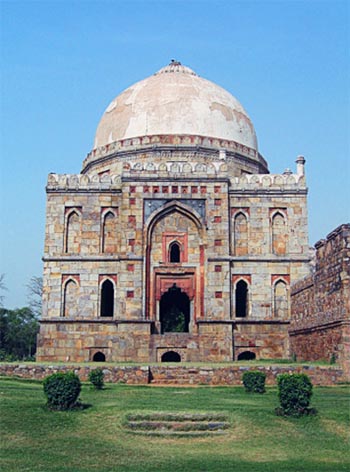 The other type of tomb of tomb was square in plan, without a verandah, and going up to three stories in height, or rather, the illusion of stories, as this effect was mostly given by lines of stones and arches as decorative elements, to make the exterior proportion acceptable, whereas the interior in reality was a double or triple height space. The façade had a central rectangle articulated by an arched doorway, and the roof, as in the octagonal type, had a dome.
The other type of tomb of tomb was square in plan, without a verandah, and going up to three stories in height, or rather, the illusion of stories, as this effect was mostly given by lines of stones and arches as decorative elements, to make the exterior proportion acceptable, whereas the interior in reality was a double or triple height space. The façade had a central rectangle articulated by an arched doorway, and the roof, as in the octagonal type, had a dome.
It seems clear enough that the octagonal tombs were reserved for the royal line, i.e. the sultans (examples being those of Mubarak Sayyid, Muhammed Sayyid, and Sikander Lodi), whereas the square tombs were for high-ranking nobles.
However, while the octagonal tombs are all identifiable, the square ones are known merely by their common names and it is not known any longer who lies buried in them.
Mosques
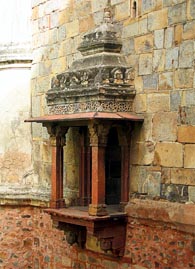 The experiment with covered-court mosques having being hastily jettisoned after the Khirki Masjid, a more conventional mosque form was resorted to in the Lodi period.
The experiment with covered-court mosques having being hastily jettisoned after the Khirki Masjid, a more conventional mosque form was resorted to in the Lodi period.
Apart from the mosques attached to tombs, one large, independent structure which was to be the forerunner of a whole series of mosques was constructed during the reign of Sikander Lodi – the Moth-ki-Masjid. The complete series, chronologically, is (i) the mosque attached to the Bara Gumbad, 1494, (ii) Moth-ki-Masjid c.1505 (iii) Jamala Mosque or Jamali-Kamali, 1536, (iv) Qila-I-Kuhna Masjid c.1550.
The last was built as Sher Shah’s private chapel and is a gem, the culmination of this mosque type.
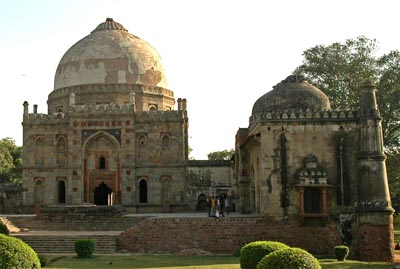 A look at the first in the series, the mosque with the Bara Gumbad, shows the genesis of the form, with five arches receding arches in the façade and domes on top.
A look at the first in the series, the mosque with the Bara Gumbad, shows the genesis of the form, with five arches receding arches in the façade and domes on top.
However, the faulty proportions as well as clumsy handling of the arches with their weak curves indicate the hesitancy of the designers in building a new typology.
The next mosque in the series, the Moth-ki-Masjid, shows the rapid crystallization of the earlier concept.
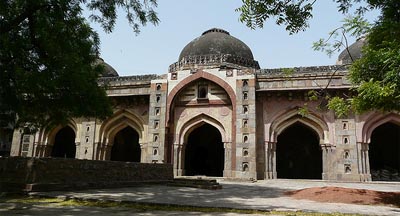 Firstly, it is considerably larger than its predecessor. Secondly, the articulation of the recessed arches is far more adept. Thirdly, embellishment has been done using elegant niches on the columns abutting the arches. Another important feature is the use of better material and color, as if the masons were trying for something more permanent and forceful.
Firstly, it is considerably larger than its predecessor. Secondly, the articulation of the recessed arches is far more adept. Thirdly, embellishment has been done using elegant niches on the columns abutting the arches. Another important feature is the use of better material and color, as if the masons were trying for something more permanent and forceful.
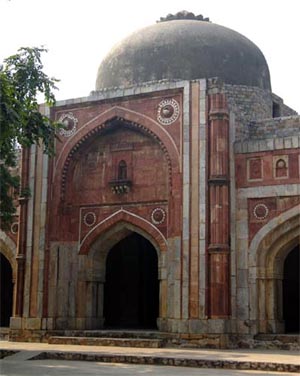 The third of the examples of this type of tomb, and the last to be discussed here, is a gem of a structure originally called the Jamala tomb, but now popularly called Jamali-Kamali. But the story of Jamali-Kamali lies elsewhere, for before it was finished, a cataclysmic event had taken place – the third battle of Panipat in 1526 A.D., when a small but well-led force of cavalry and artillery led by Babur defeated the fractious Afghan nobles led by the last Lodi Sultan.
The third of the examples of this type of tomb, and the last to be discussed here, is a gem of a structure originally called the Jamala tomb, but now popularly called Jamali-Kamali. But the story of Jamali-Kamali lies elsewhere, for before it was finished, a cataclysmic event had taken place – the third battle of Panipat in 1526 A.D., when a small but well-led force of cavalry and artillery led by Babur defeated the fractious Afghan nobles led by the last Lodi Sultan.
And so passed into history the Delhi Sultanate. It had a long history, starting from the early days of Qutb-ud-Din Aibak, passing through numerous dynasties, sultans, intrigues, wars and defeats. The Delhi Sultanate was dead, but it had left behind its legacies. Delhi would forever be the most important city in the north, the master of whom would rule India. The city itself was dotted with symbols of kings fallen and risen again, of victories and triumphs, of despair, and in its silent tombs, of eventual death.
* Brown, Percy Indian Architecture (Islamic Period) D.B. Taraporevala Sons and Co. Pvt. Ltd. Bombay, 1975, p. 26
Images under license with Gettyimages.com
04-May-2002
More by : Ashish Nangia

|
it good |

|
thanks for helping |

|
The dialogue is much appreciated. |

|
I am very impressed after reading. It is very helpful to know about the history. |

|
very helpful for my school project...thank u |

|
it has to be in all topic of history |

|
this is a most beautiful artecherter in delih sultante period |

|
there is some missing topics! please complete them. thank your team |